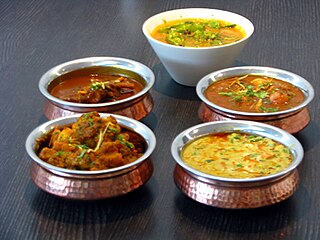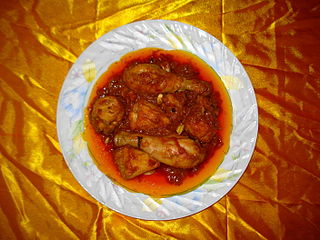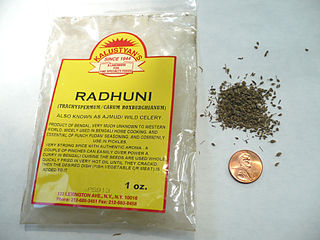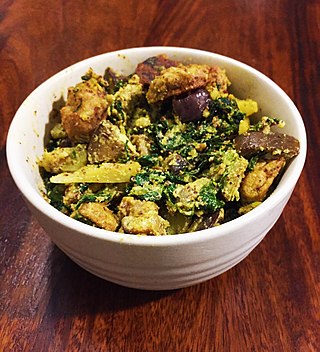
Curry is a dish with a sauce seasoned with spices, mainly associated with South Asian cuisine. In southern India, leaves from the curry tree may be included.

Five-spice powder is a spice mixture of five or more spices used predominantly in almost all branches of Chinese cuisine. The five flavors of the spices refers to the five traditional Chinese elements. The addition of eight other spices creates thirteen-spice powder (十三香), which is used less commonly.

Garam masala is a blend of ground spices originating from the Indian subcontinent. It is common in Indian, Pakistani, Nepalese, Bangladeshi, Sri Lankan and Caribbean cuisines. It is used alone or with other seasonings. The specific fixings differ by district, but it regularly incorporates a blend of flavors like cardamom, cinnamon, cumin, cloves and peppercorns. Garam masala can be found in a wide range of dishes, including marinades, pickles, stews, and curries.

Ghee is a type of clarified butter, originating from India. It is commonly used for cooking, as a traditional medicine, and for religious rituals.

Idli or idly is a type of savoury rice cake, originating from South India, popular as a breakfast food in Southern India and in Sri Lanka. The cakes are made by steaming a batter consisting of fermented black lentils (de-husked) and rice. The fermentation process breaks down the starches so that they are more readily metabolised by the body.

Vigna mungo, also known as black gram, urad bean, urid bean, matimah, matikolai, mash kalai, uzhunnu parippu, ulundu paruppu, minapa pappu, uddu, or black matpe, is a bean grown in South Asia. Like its relative, the mung bean, it has been reclassified from the Phaseolus to the Vigna genus. The product sold as black lentil is usually the whole urad bean, whereas the split bean is called white lentil. It should not be confused with the much smaller true black lentil.

Rogan josh, also spelled roghan josh or roghan ghosht, is an aromatic curried meat dish originating from Kashmir.

Korma or qorma is a dish originating in the Indian subcontinent, consisting of meat or vegetables braised with yogurt (dahi), water or stock, and spices to produce a thick sauce or gravy.

Raita is a side dish in Indian cuisine made of dahi together with raw or cooked vegetables, more seldom fruit, or in the case of boondi raita, with fried droplets of batter made from besan.

Trachyspermum roxburghianum is a flowering plant in the family Apiaceae. It is grown extensively in South Asia, Southeast Asia, and Indonesia. Its aromatic dried fruits, like those of its close relative ajwain, are often used in Bengali cuisine but are rarely used in the rest of India. The fresh leaves are used as an herb in Thailand and it is used medicinally in Myanmar and Sri Lanka.
Mithai (sweets) are the confectionery and desserts of the Indian subcontinent. Thousands of dedicated shops in India, Bangladesh, Nepal, Pakistan and Sri Lanka sell nothing but sweets.

Odia cuisine is the cuisine of the Indian state of Odisha. Compared to other regional Indian cuisines, Odia cuisine uses less oil and is less spicy, while nonetheless remaining flavourful. Rice is the staple food of this region. Mustard oil is used in some dishes as the cooking medium, but ghee is preferred in temples. Odia foods traditionally served either on brass, bronze metal plates, banana leaf or disposable plates made of sal leaves.

Chorchori or charchari is a unique char-flavored mixed vegetable dish of India and Bangladesh, found primarily in Odia and Bengali cuisine of the Indian subcontinent.
Tatsama are Sanskrit loanwords in modern Indo-Aryan languages like Assamese, Bengali, Marathi, Nepali, Odia, Hindi, Gujarati, and Sinhala and in Dravidian languages like Tamil, Kannada and Telugu. They generally belong to a higher and more erudite register than common words, many of which are directly inherited from Old Indo-Aryan (tadbhava). The tatsama register can be compared to the use of loan words of Greek or Latin origin in English.
Tadbhava is the Sanskrit word for one of three etymological classes defined by native grammarians of Middle Indo-Aryan languages, alongside tatsama and deśi words. A "tadbhava" is a word with an Indo-Aryan origin but which has evolved through language change in the Middle Indo-Aryan stage and eventually inherited into a modern Indo-Aryan language. In this sense, tadbhavas can be considered the native (inherited) vocabulary of modern Indo-Aryan languages.

Baigan (बैगन) bharta or Baigan Chokha is an Indian dish prepared by mincing grilled eggplant (baigan) and mixing it with tomato, onion, herbs and spices. Grilling the eggplant over charcoal or direct fire infuses the dish with a smoky flavour. Mashed eggplant is then mixed with cooked chopped tomato, browned onion, ginger, garlic, cumin, fresh cilantro, chili pepper, and mustard oil or a neutral vegetable oil. Traditionally, the dish is often eaten with flatbread and is also served with rice or raita, a yogurt salad. In Bihar and Uttar Pradesh, it is served hot with litti or baati.
Bihari cuisine is eaten mainly in the eastern Indian state of Bihar, as well as in the places where people originating from the state of Bihar have settled: Jharkhand, Eastern Uttar Pradesh, Bangladesh, Nepal, Mauritius, South Africa, Fiji, some cities of Pakistan, Guyana, Trinidad and Tobago, Suriname, Jamaica, and the Caribbean. Bihari cuisine includes Bhojpuri cuisine, Maithil cuisine and Magahi cuisine.

Paratha is a flatbread native to the Indian subcontinent, with earliest reference mentioned in early medieval Sanskrit text from Karnataka, India; prevalent throughout the modern-day nations of India, Sri Lanka, Pakistan, Nepal, Bangladesh, Maldives, Afghanistan, Myanmar, Malaysia, Singapore, Thailand, Mauritius, Fiji, Guyana, Suriname, and Trinidad and Tobago where wheat is the traditional staple. It is one of the most popular flatbreads in the Indian subcontinent and the Middle East. Paratha is an amalgamation of the words parat and atta, which literally means layers of cooked dough. Alternative spellings and names include parantha, parauntha, prontha, parontay, paronthi (Punjabi), porota, paratha, palata, porotha, forota, farata, prata, paratha, buss-up shut, oil roti and roti canai in Malaysia and Indonesia.

In Indian cuisine, dal, paruppu, or pappu are dried, split pulses that do not require soaking before cooking. India is the largest producer of pulses in the world. The term is also used for various soups prepared from these pulses. These pulses are among the most important staple foods in South Asian countries, and form an important part of the cuisines of the Indian subcontinent.
Indian cookbooks are cookbooks written in India, or about Indian cooking. Some of the oldest cookbooks were written in India Indian cooking varies regionally and has evolved over the centuries due to various influences. Vegetarianism has made a significant impact on Indian cooking. Spices play a major role in Indian cooking.
















